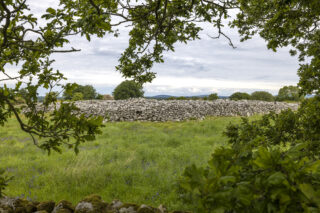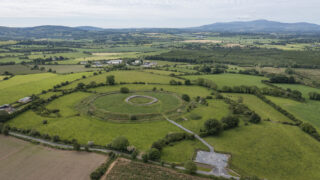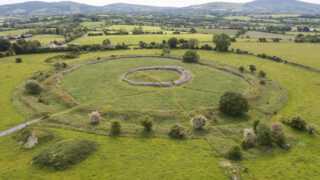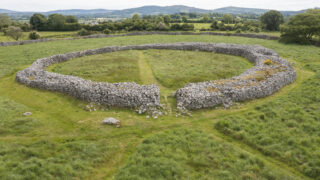Facilities
- Car park
Rathgall Ringfort is a state-owned National Monument in the care of the Office of Public Works
WARNING: It should be noted that these sites are unguided and a level of care and caution should be maintained during all stages of your visit. The Office Of Public Works (OPW) will not be held responsible for any damages, injuries, or losses that occur
Named in Irish as An Ráth Gheal (The Bright Fort) and also known as An Rath Gall (The Fort of Foreigners or The Fort of Strangers), this important Bronze Age hillfort, dating mainly to the 12th and 11th centuries BC, is situated in the townland of Rath East.
Tradition links the site to Celtic royalty, specifically to Crundmáel Bolg Luatha mac Áedo (who died in 628 AD), a King of the Uí Ceinnselaig family dynasty, who were mostly based in the east of Co. Carlow and the north of Co. Wexford.
Rathgall lies on the edge of a ridge with extensive panoramic views and consists of three concentric stone ramparts dating to the Bronze Age, with a fourth inner stone circle dating to, or certainly updated in, the medieval period. The monument encompasses a total area of 7.5 hectares (18 acres), of which its inner circle diameter measures 15 metres.
Revealing excavations by the archaeologist Professor Barry Raftery (1944-2010), which started in 1969, unearthed important evidence for early and late Bronze Age activity throughout the site. During the first year of his excavations, over 10,000 objects were found in the inner circle, including stone, glass, and gold objects, as well as clay moulds that were used for the casting of large quantities of bronze tools and weapons. The huge numbers of objects found support the theory that the site was occupied by an important wealthy family, or a small but highly productively-active community.
During Professor Raftery’s various excavations, post holes identified within the centre circle revealed the presence of a small house. One of many important funerary discoveries that he made was a pit, sealed by a large, carefully-placed boulder, within which, mingled amongst a baby’s burnt bones, was found a 1 centimetre-wide gold-plated copper ring.
During subsequent excavations in the years of 1972 and 1973, 400 objects per day were unearthed, including glass, gold, animal bones, pottery and basket remains, as well as evidence of grain-growing and animal husbandry.
In the 1974 dig season, was an unprecedented discovery for the middle and late Bronze Age in Ireland and also in Western Europe: eighty eight blue-green coloured glass beads were uncovered, each with a hole in the middle. Professor Raftery also found a 2 centimetre long twisted coiled cylinder with finely hammered ends, with a 2 to 3 centimetre dark green glass bead mounted in the middle. He also found a mercury-gilded metal disc. Mercury gilding was used to adhere bronze to gold and a British Museum analysis dated the piece to 1,000 BC, 600 years earlier than the previously known earliest example of such a gilding technique.
An iron-smelting furnace indicated that Rathgall was occupied for a short period during the Iron Age, while medieval coins, alongside green-glazed pottery of a medieval character, indicated that the site was occupied during the 12th and 13th centuries AD.
Professor Raftery’s excavations revealed Bronze Age finds of unprecedented interest, the quantity and quality of which have not yet been matched elsewhere in Ireland.
Visit Historic Environment Viewer for more information on Rathgall Ringfort
Protect our Past - Click here to read about the importance of protecting our country’s unique heritage sites
This national monument is protected in accordance with the National Monuments Acts 1930 to 2014




Old-world gardens with an atmosphere all of their own
Approx. 8.4 km from Rathgall Ringfort
An unlikely battle-site of the 1798 Rebellion
Approx. 19.0 km from Rathgall Ringfort
Two nations, two cultures and one shared heritage
Approx. 26.0 km from Rathgall Ringfort
A valley of sanctuary for saints and scholars
Approx. 32.4 km from Rathgall Ringfort
Records written in stone in the heart of Gowran
Approx. 33.2 km from Rathgall Ringfort
An oasis of rare horticultural delights
Approx. 37.4 km from Rathgall Ringfort